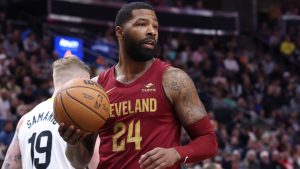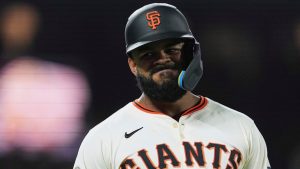James Harden is less efficient, Nikola Vučević is careering, and the Kings are concerning, but what is real?
One of the great things about sports is the unpredictable nature of future events.
Great new heroes can rise from the clashes between bitter rivals to cement themselves as the names of tomorrow, just as the older generation can slowly fade into oblivion from one season to the next.
The very fact that we simply don’t know what to fully expect is why we tune in, religiously, to keep track of the ins and outs of a 24/7 league.
One such element, such as scoring efficiency, can also be unpredictable and dramatically alter the course of events, leaning into both our enjoyment or disappointment, pending which side you lean.
Five players and one team stand out this year as having diverged from their regular paths. Given that it’s still early in the season, it’s time to give them a look and ponder the overarching question: Is this anything?
’24-25: 37.9 FG%, 31.0 3FG%, 54.1 TS%’23-24: 42.8 FG%, 38.1 3FG%, 61.2 TS%
The former MVP has seen his efficiency dip, quite substantially, in the early parts of this season, and the problem is pretty much everywhere.
The 6-foot-5 Harden has always been built like a tank, using raw strength to get to the rim, while converting nearly 64% of his shots within three feet over the course of his career.
Before the weekend, Harden was down to 53.3% this year, which means he was essentially blowing half of his shots near the basket — a worrying decline for a player who used to practically live there to draw fouls and finish shots over taller opponents.
Harden is 35 now, and his legs have a lot of minutes on them. Counting both the regular season and playoffs, which comes out to over 43,500 minutes collectively, it’s no surprise that Harden is feeling the sting of a body that’s no longer able to take the punishment.
This doesn’t mean the All-Star guard isn’t productive. Despite his shooting woes, he’s still posting 20.6 points, 7.9 rebounds and 8.5 assists per game, numbers that could easily carry him through the season. But the lack of efficiency and athletic pop are real concerns.
Is this anything?
Yes and no. Harden’s athletic decline will cost him some efficiency points around the rim, but he’s smart enough to find ways to compensate. The 3-point shot is likely to bounce back, which he could lean into more and thus get back on track. But his game has changed, and the sooner we accept that, the better.
’24-25: 59.3 FG%, 44.6 3FG%, 67.9 TS%’23-24: 48.4 FG%, 29.4 3FG%, 54.0 TS%
No Bulls fan alive will call the 2021 trade deadline acquisition of Vučević a win. The Bulls ended up relinquishing Wendell Carter Jr., as well as the rights to Franz Wagner and Jett Howard.
What they got in return was an inconsistent center who could never quite get the hang of his role, despite the fact his strengths overwhelmingly were on the offensive side of the ball.
This season Vučević is playing All-Star-caliber basketball, hitting everything from everywhere, including a near 13 percentage point increase in his conversion rate around the basket.
Some might argue that the floor has opened up due to the departure of DeMar DeRozan, allowing the Montenegrin more space to operate. There could be some truth to that logic, although it hardly explains his sudden explosion as a 3-point shooter.
The Bulls should hope a number of teams buy into Vučević’s new numbers, so they can pivot off him in a trade and get back something that could help a future rebuild, which still needs to happen.
Is this anything?
No. Vučević will end up having a better season than last because of his excellent start, but unless he makes a drastic change at the age of 34 to turn into the center version of Kevin Durant, his numbers are entirely unsustainable. Make the most out of this situation, Chicago.
’24-25: 33.7 FG%, 23.4 3FG%, 47.0 TS%’23-24: 46 FG%, 40.6 3FG%, 60.2 TS%
The world went absolutely nuts when the Denver Nuggets failed to retain their starting shooting guard, leading to cascades of criticism of their internal process.
Orlando, concurrently, was celebrated for signing the two-way wing to $66 million over three years.
As it stands right now, with Denver handing Christian Braun the spot formerly occupied by Caldwell-Pope and Braun flourishing in that role, the tables have seemingly turned.
Caldwell-Pope is no longer playing off the best playmaker in the NBA in Nikola Jokić, and he’s playing on a team that still needs a reliable point guard to set the offense on the right path. That explains some of this, but not all.
Fact is, Caldwell-Pope is in an epic shooting slump, making it nearly impossible to gauge his true capabilities due to the aforementioned factors.
Is this anything?
Yes. Caldwell-Pope greatly benefited from playing with Jokić, who passed him the ball 12.3 times per game last year, providing a reliable baseline for what he could expect whenever he took the floor. That predictable presence is gone now, and it’s going to affect his play. That doesn’t mean he won’t improve as the season goes on — but his elite shooting isn’t likely to return this year.
’24-25: 50.7 FG%, 38.2 3FG%, 62.4 TS%’23-24: 47.2 FG%, 31.1 3FG%, 56.9 TS%
If you think Randle’s efficiency disparity is minimal, you’re not necessarily wrong.
However, this boils down to expectations. Randle was joining a frontcourt of Rudy Gobert and Jaden McDaniels, meaning spacing wasn’t going to be a major presence.
But Randle has connected on a ton of outside shots (including a game-winning 3-pointer on Sunday), converted on a higher rate of his shots near the rim and generally looked far more at home in Minnesota’s offense than expected.
That doesn’t mean he’s been a seamless fit, as the Wolves are playing a level or two below what they did last year. But Randle has somehow found success within a confusing roster construction, playing off the attention given to Anthony Edwards and leaning into the role of a secondary scorer. That seems to have benefited him.
Is this anything?
Oddly enough, yes. Randle seems to take one year on and one year off from his efficiency numbers, and this season looks like it’s on. He’s found a niche within the offensive structure and has been given the green light to create more, leading to a boost in confidence and shot-making. Go figure!
’24-25: 30.9 FG%, 21.9 3FG%, 39.6 TS%’23-24: 46.8 FG%, 40.8 3FG%, 61.3 TS%
Yes, yes. Caruso is a defensive connector and not a high-scoring shooter, so why are we looking at his specific efficiency?
Well, to start, because the disparity is enormous and also due to the expectations of being added to a loaded Thunder squad, where open shots would be easy to come by, all within the flow of the offense.
That has all materialized, and Caruso is seemingly too open, with 43.6% of his shots deemed “wide open,” meaning the closest defender is more than six feet away. On those shots, Caruso is converting on just 20.8%, an unfathomably low number.
This comes on the heels of the best shooting season of his career, turning himself into a far more dangerous weapon.
Fortunately, his role is low volume, and the Thunder can produce efficient offense without him. It’s not a big issue — at least not until he starts to brick those same shots in the playoffs.
Is this anything?
Despite the woeful percentages … not yet. Caruso has taken 55 shots on the season, 32 of which have been 3-pointers. The sample size is so low that one week of consistent shooting could swing the percentages back in his favor. If by the middle of January he’s still struggling to this extent, then it’s time to get worried.
’24-25: 33.1 3FG%, 24.6 assists, 34.4 3PA’23-24: 36.6 3FG%, 28.3 assists, 39.3 3PA
Remember the space Vučević got freed up due to DeMar DeRozan’s departure? Well, the Kings might have taken that on.
DeRozan has been brilliant for Sacramento, but he remains an absolute space eater and heavy isolation scorer who does take over the offense. That’s great when he’s converting at a high rate, drawing fouls and setting teammates up.
But it does come with the cost of the ball moving less. The Kings, who have both De’Aaron Fox and Domantas Sabonis to set people up, rank 22nd in the league in assists now, when it should have gone in the opposite direction.
Their 3-point shooting has also declined. They ranked third last season in 3-point attempts but 23rd this season in that department, while barely cracking 31% efficiency.
This isn’t all on DeRozan, of course. The Kings have embraced the midrange shot and are actively seeking it more than they did last year. Will that cost them wins at the end of the season? It depends on how many close games DeRozan and Fox bail them out of, but otherwise the answer should be yes.
Sacramento has sported an explosive offensive identity over the past few seasons, and it’s trying to retain that by adding volume via DeRozan. Having three scorers who can all get you 25 points whenever needed is indeed a luxury, but is it a luxury the Kings can afford if it comes at the expense of the unpredictability of their offense?
Is this anything?
There’s a world wherein this works, as long as DeRozan is capable of scaling back as the season progresses, especially to allow Keegan Murray’s skills as a shooter to excel. If not, this could be something, and that something might not be well-received by Kings fans.












